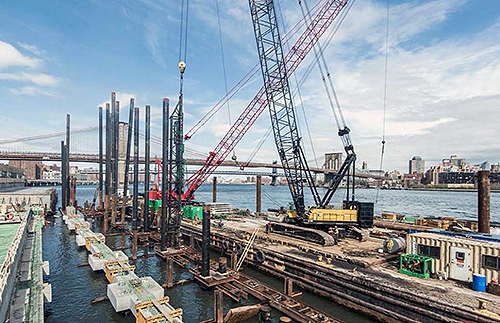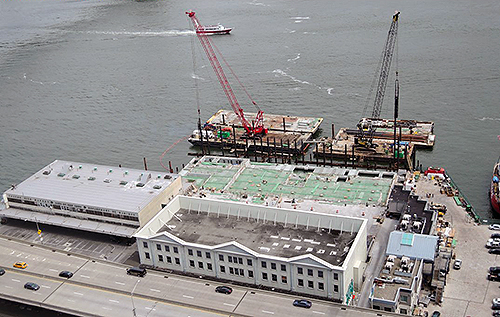 The South Street Seaport is a historic area in NYC borough of Manhattan where Fulton Street meets the East River and adjacent to the Financial District. In 1982 the redevelopment turned the Museum into a greater tourist attraction by the development of a shopping area. In 2012 Hurricane Sandy heavily damaged the Seaport. Howard Hughes Corporation, the Seaports owner, announced the reconstruction of the site and revitalization of the area.
The South Street Seaport is a historic area in NYC borough of Manhattan where Fulton Street meets the East River and adjacent to the Financial District. In 1982 the redevelopment turned the Museum into a greater tourist attraction by the development of a shopping area. In 2012 Hurricane Sandy heavily damaged the Seaport. Howard Hughes Corporation, the Seaports owner, announced the reconstruction of the site and revitalization of the area.
In 2010 Trevcon Construction, a New Jersey based marine contractor, had received a contract for construction work for New York Belt Parkway in Brooklyn. Part of the work included some temporary structures. They were looking for a pile to carry 200 tons without being filled with concrete. They inquired if DFP Foundation Products LLC could produce a TAPERTUBE® PILE in 24” diameter with a .500” wall in 50 ksi steel. We responded that this was not a problem. We supplied a drawing of the proposed pile and it was approved and ordered.
The piles were successfully installed and when they were no longer needed they were removed and stored.
Aerial photo of Tapertube®
piles in the water. Tin Building in the foreground.
 In 2014 the project for the replacement of New York City Pier 17 that is located in the Borough of Manhattan along the East River. Pier 17 reconstruction was awarded to Trevcon Construction by Hunter Roberts Construction Group. The project owner is the Howard Hughes Corporation.
In 2014 the project for the replacement of New York City Pier 17 that is located in the Borough of Manhattan along the East River. Pier 17 reconstruction was awarded to Trevcon Construction by Hunter Roberts Construction Group. The project owner is the Howard Hughes Corporation.
The project work called for the demolition of all existing pier, structures, concrete piles and caps, plans and timber fender system and the construction of a new 133,651 square foot pier.
The original design called for 846 ea. 24” open-end piles and the entire Pier 17 as one pier. The revised pier and pile design due to the new flood maps requirement, as the result of Hurricane Sandy, reduced the total pile count to 810 for the entire Pier 17. Pier 17 was divided into two piers. The first is The Main Pier, which the new building will sit upon. This Pier was designed by CH2M Hill. The second is The Ancillary Pier, which was designed by McLaren. [This information was supplied by Danny Li Assistant VP of Trevcon who was in charge of the construction.]
When Trevcon did the static and dynamic tests for the straight pipe pile, they could not achieve a 200 ton capacity called for. Using the TAPERTUBE spliced to 24" pipe produced the 250 ton piles required.
There were two pile capacities - 434 piles at 150 tons and 376 piles at 250 tons. All 250 ton piles were TAPERTUBE. Approximately 80 of these piles were extracted piles in storage from the temporary piles from the Belt Parkway project. The balance were new.
The TAPERTUBE used for this project were 12.5" x 24" x 20' x .500" wall 50 ksi steel fitted with a cast steel driving point made to ASTM A-148 Grade 90/60, also made by DFP Foundation Products, LLC.
ADDITIONAL JOB AT PIER 17 - RELOCATING THE TIN BUILDING
In 2016 an additional contract was awarded to Trevcon Construction to disassemble and relocate the TIN BUILDING to the east on the pier. First constructed in 1907 and once part of the Fulton Fish Market and is recognized as a landmark structure. The move is to locate the building one foot above the new flood plane and away from the East River Drive structure.
The 2012 Hurricane Sandy flooded the building, and more importantly the existing timber foundation piles which have deteriorated to the point of possible collapse. The new foundation plan is to install 200 ea. 12”x 24”x 20’x .500” wall TAPERTUBE PILES to be extended with 24”x 500” steel pipe. This project will likely begin at the end of 2016.
The taper of the TAPERTUBE PILE increases the load capacity for a friction pile. The increase in capacity in addition to the side friction and toe bearing, comes from what has been demonstrated conclusively by Kodikara ca. 1990 as "cylindrical cavity expansion". Essentially, for the tapered section to further penetrate the soil, it must displace the surrounding soil to enlarge the cavity and therefore becomes a third mechanism in load capacity.


 The South Street Seaport is a historic area in NYC borough of Manhattan where Fulton Street meets the East River and adjacent to the Financial District. In 1982 the redevelopment turned the Museum into a greater tourist attraction by the development of a shopping area. In 2012 Hurricane Sandy heavily damaged the Seaport. Howard Hughes Corporation, the Seaports owner, announced the reconstruction of the site and revitalization of the area.
The South Street Seaport is a historic area in NYC borough of Manhattan where Fulton Street meets the East River and adjacent to the Financial District. In 1982 the redevelopment turned the Museum into a greater tourist attraction by the development of a shopping area. In 2012 Hurricane Sandy heavily damaged the Seaport. Howard Hughes Corporation, the Seaports owner, announced the reconstruction of the site and revitalization of the area. In 2014 the project for the replacement of New York City Pier 17 that is located in the Borough of Manhattan along the East River. Pier 17 reconstruction was awarded to Trevcon Construction by Hunter Roberts Construction Group. The project owner is the Howard Hughes Corporation.
In 2014 the project for the replacement of New York City Pier 17 that is located in the Borough of Manhattan along the East River. Pier 17 reconstruction was awarded to Trevcon Construction by Hunter Roberts Construction Group. The project owner is the Howard Hughes Corporation.